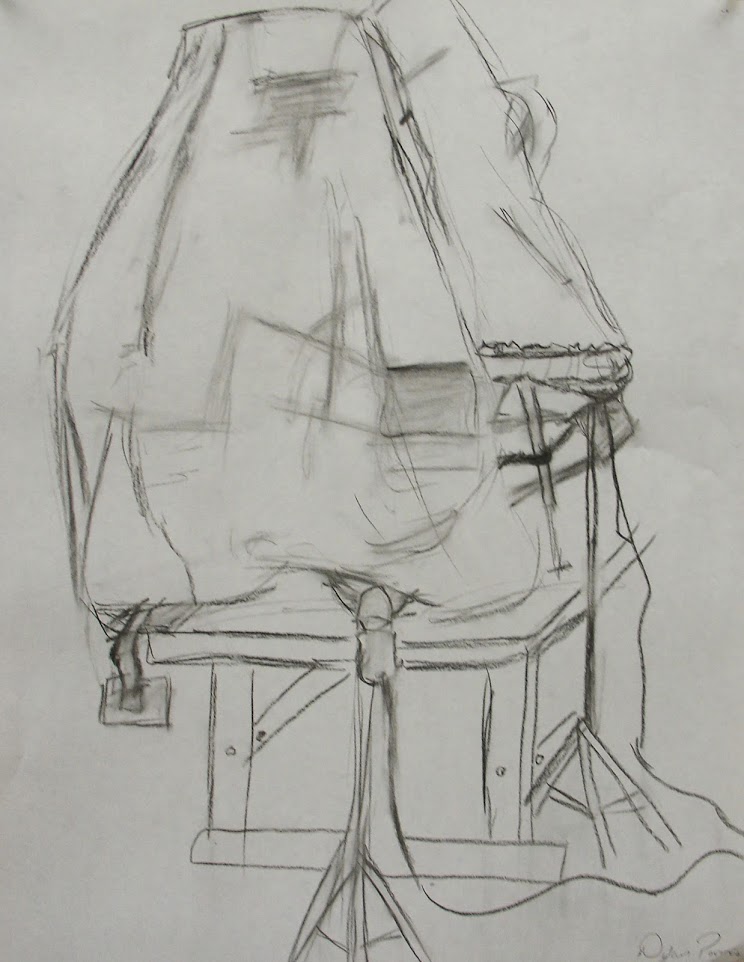Learning Objectives
1. Develop observational, compositional and conceptual problem-solving skills (supports PLO 6).
2. Demonstrate proficiency in the use of basic drawing media (supports PLO 6).
3. Demonstrate various drawing techniques (supports PLO 6).
4. Develop critical thinking skills as they apply to the visual arts (supports PLO 4 and 6).
Materials
- Newsprint
- Vine Charcoal
Info
Gesture drawing explores the form and movement of an object in space, as your eye follows its shape. Often it may look quite realistic, but more often gesture drawings will have just a sense of the overall form. Gesture drawing isn’t an outline, nor is it an abstract drawing. It might not always look realistic though, because it isn’t trying to represent the figure in a photographic way, but trying to suggest the essential feeling of the subject.
Imagine you are describing the object with your hands as you talk to someone – those hand gestures are very like those you make when gesture drawing. The marks are quick and deliberate. You look at the subject and try to sum it up with a few marks, as you might describe it in a few words. Because you don’t have much time, each word – each mark – in a gesture drawing must say something significant about the subject.
When creating a gesture drawing, according to Kimon Nicolaides in ‘The Natural Way to Draw’, “you should draw, not what the thing looks like, but what it is doing. You need to ‘sense’ the thing that you are drawing. Is it fluid and soft, or spiky and hard? Is it coiled like a spring, or off-center and asymmetric, or is it solid and balanced?
By nature gesture drawing tends to be done rapidly. Loose, often circular marks capture the flow of forms. Look at the whole object and notice points of tension, direction of weight or pressure, spaces, protrusions into space.
Sketchbook
- 5 gestures of living objects and 5 gestures of non-living objects. These should be done with pencil in your sketchbook, drawn from life and should be done in less than a minute each.
- Check out one book from the library, preferably from the Art section. You can also find images online but they need to be of real things – not images of paintings or other 2 dimensional works. Flip through the book and find 20 images that are visually appealing. Draw each of these images in your sketchbook. 1 page per image (you can draw on the back and front). Do these as quickly as possible but not more than a minute each.
- Answer these questions in your sketchbook: Why do we begin with gestures? What is the role of empathy in drawing? What does “movement” have to do with it? In what ways does gesture inform us in our drawing?
Project
Students will set up a table with a low stool or box on top. They will then cover this with a white fabric, black fabric, or striped fabric. Students will be instructed on how to correctly set up a still life using a 3 stage method (ground, table, and stool). Students need to create areas of interest on all sides. Students will also be directed to look for good compositions.
Gestures are designed to capture movement and overall form, not detail. This type of drawing should be done with the whole body, especially the arm.
Examples
1 Minute Gesture (5, drawing different objects each time)
2 Minute Gesture (15, rotate to the right for each drawing)
1 Minute to 5 Minute (3, start with only 1 minute, then allow students to add details)
5 Minute (3, change positions, low, medium, high)
Research
Michelangelo, Rodin, Alberto Giacometti, Edward Degas


